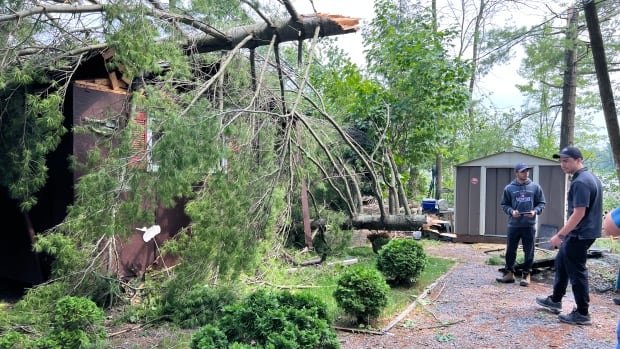Canada's Tornado Alley may be moving from Prairies to Ontario-Quebec, warn researchers
Researching changing tornado patterns in Canada14 days agoDuration 1:58Tornadoes have not only become more common in Canada, but they’re also happening in different places. CBC’s Thomas Daigle hit the road with researchers trying to determine what’s causing the changes.The tornadoes that ripped across suburban Ottawa and near Montreal on Thursday highlight a growing concern for researchers.Preliminary data trends suggest Canada's most densely populated zone — in Ontario and Quebec — may become the country's epicentre for twisters, with increasingly devastating consequences."What we're seeing is lining up with climate change projections," David Sills, executive director of the Northern Tornadoes Project (NTP), told CBC News. He pointed to information collected in recent years by the team based at Western University in London, Ont.Canada's Tornado Alley, long considered to be largely in the Prairies, appears to be moving east, home to millions more people."We have a lot more work to do t

The tornadoes that ripped across suburban Ottawa and near Montreal on Thursday highlight a growing concern for researchers.
Preliminary data trends suggest Canada's most densely populated zone — in Ontario and Quebec — may become the country's epicentre for twisters, with increasingly devastating consequences.
"What we're seeing is lining up with climate change projections," David Sills, executive director of the Northern Tornadoes Project (NTP), told CBC News. He pointed to information collected in recent years by the team based at Western University in London, Ont.
Canada's Tornado Alley, long considered to be largely in the Prairies, appears to be moving east, home to millions more people.
"We have a lot more work to do to collect data to make sure those trends are robust," Sills, a former Environment Canada tornado investigator, said in an interview. "But it certainly seems that that's the case. And that's not great news, [with] a lot of population in this area from Windsor [Ont.] to Quebec City."
Canada reports more tornadoes than any other country, except the U.S.
Sills's NTP team seeks to gain a clearer picture of exactly how many twisters are hitting Canada, by compiling the most comprehensive database the country's ever had.
When they started tracking the data, they pinpointed 70 tornadoes in 2017. As their work expanded and the team received more reports from the public, the numbers grew to 118 confirmed tornadoes in 2021 and another 117 last year.
"We've noticed just in the work we've done since 2017… there's a heck of a lot of tornadoes that seem to be happening in eastern Ontario [and] southwestern Quebec, and not quite as much happening on the Prairies," Sills said.
A CBC News crew recently followed a team from the NTP as they investigated a suspected twister in rural Tweed, Ont., northwest of Kingston. Analyzing weather data, then using a drone to map damage from above and inspecting downed trees and other debris on the ground, the researchers concluded the area had been hit by two tornadoes — both classified on the enhanced Fujita (EF) scale as an EF-0.
By comparison, the tornado that destroyed several homes in central Alberta on Canada Day was considered an EF-4, one of the most powerful twisters in the country's history.

An EF-4 signals wind speeds between 332 and 418 km/h. The EF scale tops out at 5, with even high wind speeds and "massive devastation," according to Public Safety Canada.
Canada's deadliest tornado tore through Regina in 1912. The EF-4 killed 28 people and left 2,500 homeless. If such extreme weather proves increasingly common in Central Canada, it poses an even greater risk, say experts, with some 18 million people living between Windsor and Quebec City.
Aaron Jaffe, an NTP researcher who led the team on the ground in Tweed, warned against minimizing twisters classified only as EF-0 or EF-1.
"All it takes is a tree to fall into the house or cottage, and then you have significant damage," he said.
Building resiliency
Part of the work by the NTP seeks to build Canada's resiliency to tornadoes.
"If we know where they're happening with greater precision, we can come up with adaptation strategies that make a lot more sense," said Greg Kopp, an engineering professor at Western University.
Kopp said Canadian building codes need to be updated to reflect the growing risk posed by tornadoes, and homebuilders should consider small investments to lessen the potential impact of a twister.
"Twenty years ago when we started talking about this, the only reaction we ever got was, 'You're crazy,'" said Kopp, who acts as NTP's lead researcher.
He said simple additions to new builds, such as hurricane straps or roof clips, could help prevent major damage and only cost a few hundred dollars. The small connectors can keep roofs attached, even in the event of an EF-2 tornado, Kopp added.
What's Your Reaction?














